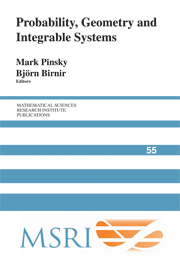Book contents
- Frontmatter
- Contents
- Preface
- Henry McKean: A tribute by the editors
- Bitangential direct and inverse problems for systems of differential equations
- Turbulence of a unidirectional flow
- Riemann–Hilbert problem in the inverse scattering for the Camassa–Holm equation on the line
- The Riccati map in random Schrödinger and random matrix theory
- SLE6and CLE6 from critical percolation
- Global optimization, the Gaussian ensemble, and universal ensemble equivalence
- Stochastic evolution of inviscid Burgers fluid
- A quick derivation of the loop equations for random matrices
- Singular solutions for geodesic flows of Vlasov moments
- Reality problems in the soliton theory
- Random walks and orthogonal polynomials: some challenges
- Integration of pair flows of the Camassa–Holm hierarchy
- Landen Survey
- Lines on abelian varieties
- Integrable models of waves in shallow water
- Nonintersecting Brownian motions, integrable systems and orthogonal polynomials
- Homogenization of random Hamilton–Jacobi–Bellman Equations
The Riccati map in random Schrödinger and random matrix theory
Published online by Cambridge University Press: 27 June 2025
- Frontmatter
- Contents
- Preface
- Henry McKean: A tribute by the editors
- Bitangential direct and inverse problems for systems of differential equations
- Turbulence of a unidirectional flow
- Riemann–Hilbert problem in the inverse scattering for the Camassa–Holm equation on the line
- The Riccati map in random Schrödinger and random matrix theory
- SLE6and CLE6 from critical percolation
- Global optimization, the Gaussian ensemble, and universal ensemble equivalence
- Stochastic evolution of inviscid Burgers fluid
- A quick derivation of the loop equations for random matrices
- Singular solutions for geodesic flows of Vlasov moments
- Reality problems in the soliton theory
- Random walks and orthogonal polynomials: some challenges
- Integration of pair flows of the Camassa–Holm hierarchy
- Landen Survey
- Lines on abelian varieties
- Integrable models of waves in shallow water
- Nonintersecting Brownian motions, integrable systems and orthogonal polynomials
- Homogenization of random Hamilton–Jacobi–Bellman Equations
Summary
We discuss the relevance of the classical Riccati substitution to the spectral edge statistics in some fundamental models of one-dimensional random Schrödinger and random matrix theory.
1. Introduction
The Riccati map amounts to the observation that the Schr¨odinger eigenvalue problemis transformed into the first order relation
q(x) = ƛ +. p′(x)+p2>′(x)
upon setting. That this simple fact has deep consequences for the problem of characterizing the spectrum of Q with a random potential q has been known for some time. It also turns out to be important for related efforts in random matrix theory (RMT). We will describe some of the recent progress on both fronts.
Random operators of type Q arise in the description of disordered systems. Their use goes back to Schmidt [1957], Lax and Phillips [1958], and Frisch and Lloyd [1960] in connection with disordered crystals, represented by potentials in the form of trains of signed random masses, randomly placed on the line. Consider instead the case of white noise potential, q(x) =b′(x) with a standard brownian motion x ⟼ b(x), which may be viewed as a simplifying caricature of the above.
Information
- Type
- Chapter
- Information
- Probability, Geometry and Integrable Systems , pp. 77 - 102Publisher: Cambridge University PressPrint publication year: 2008
